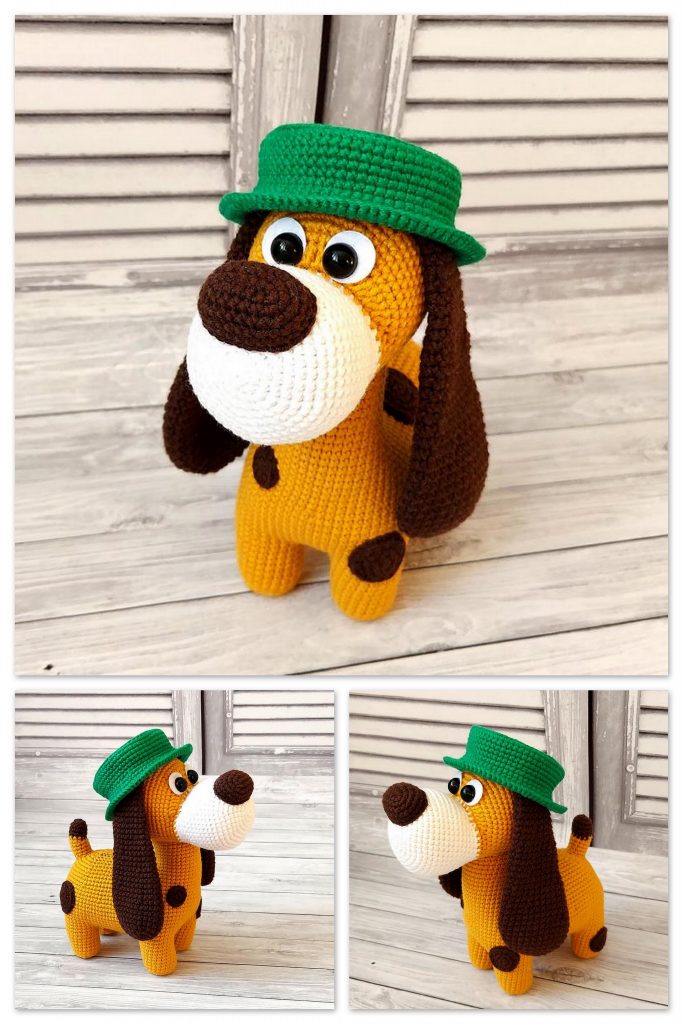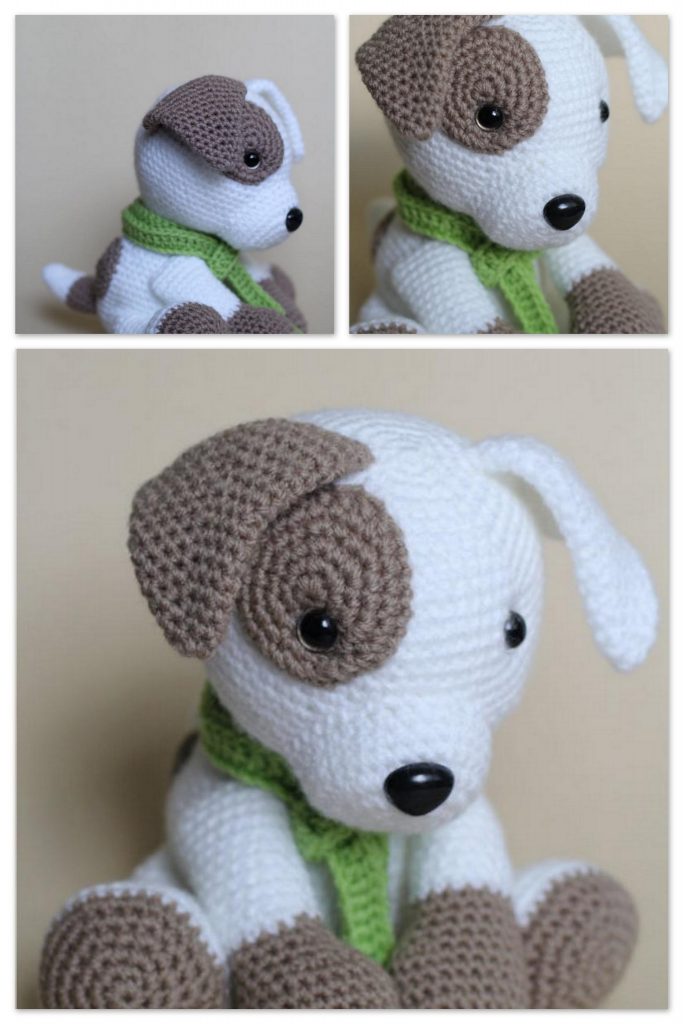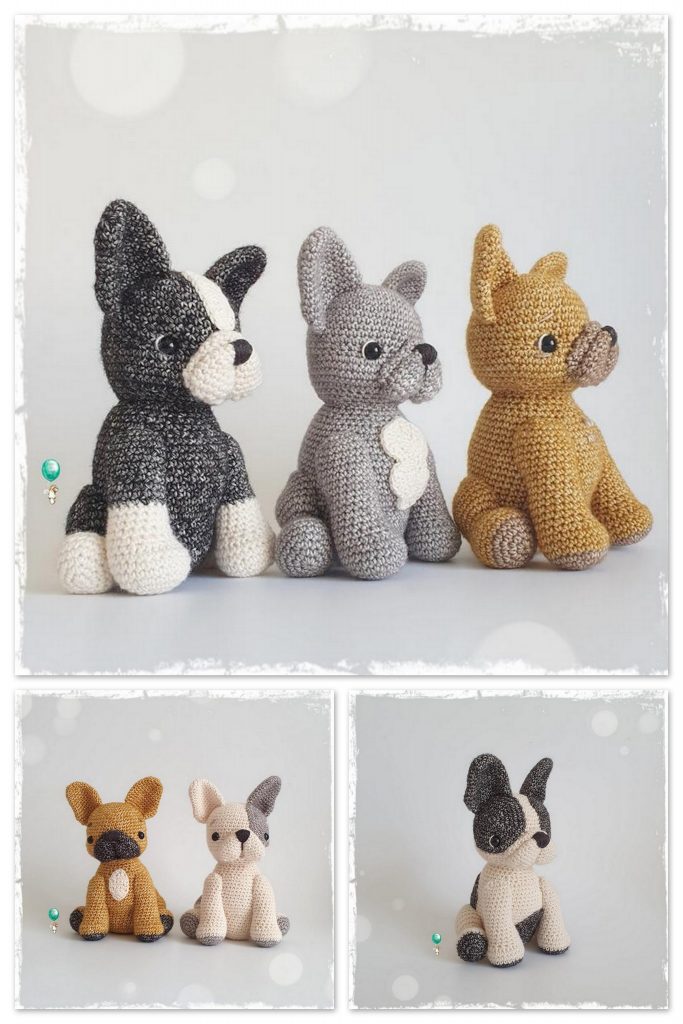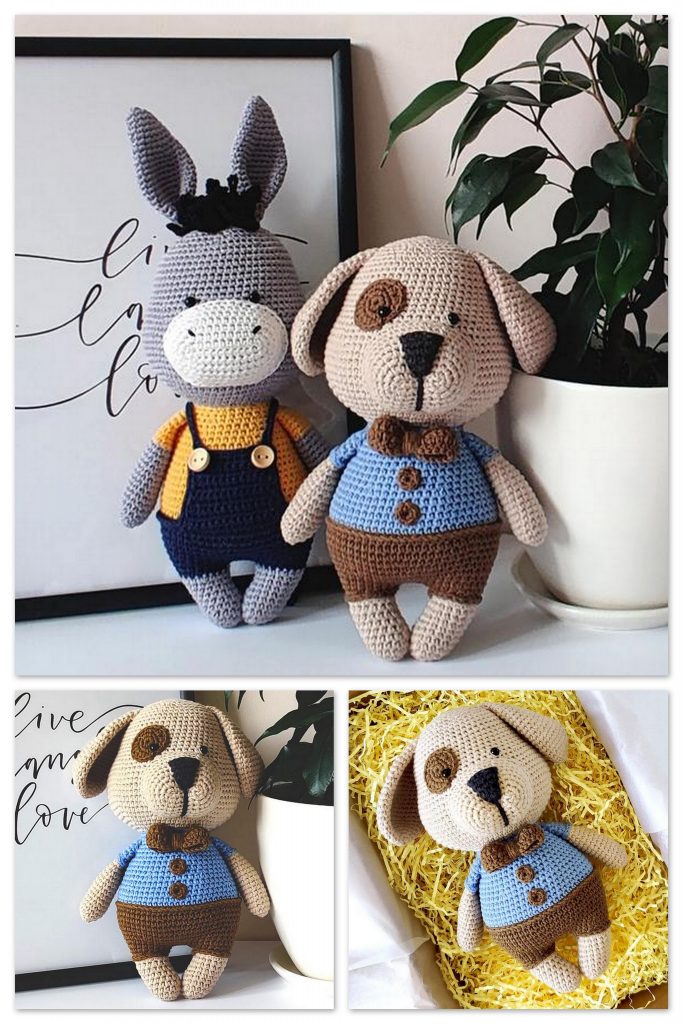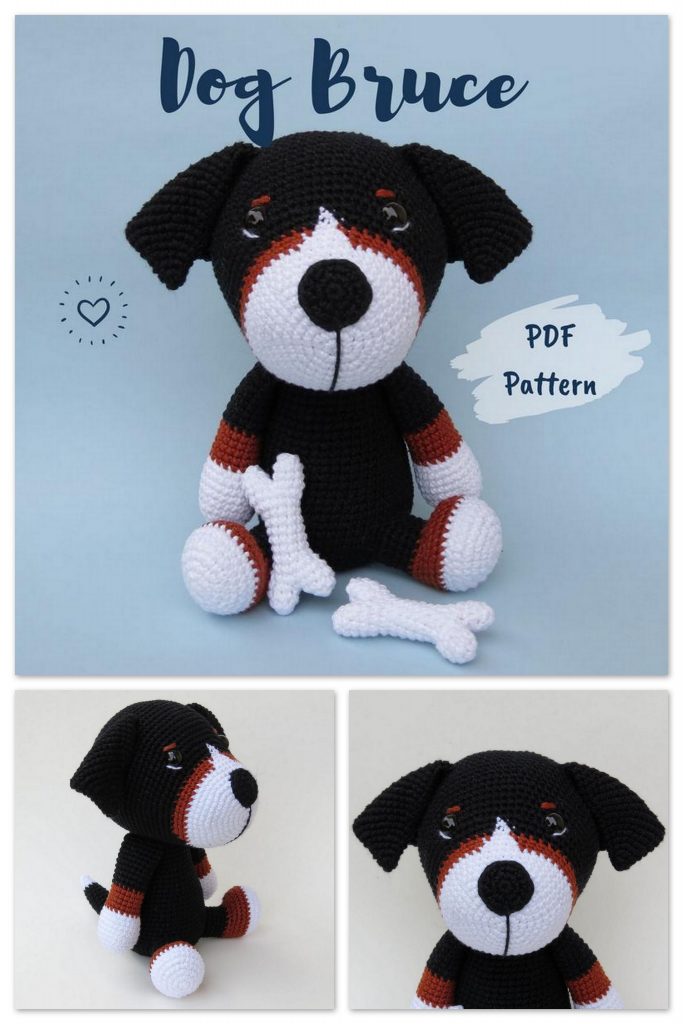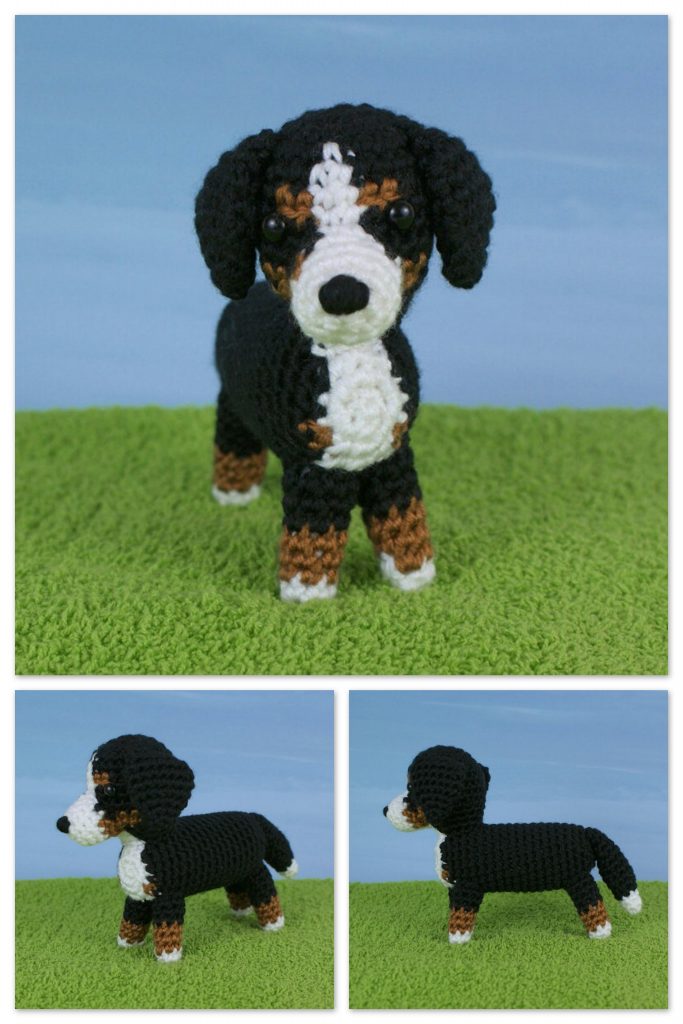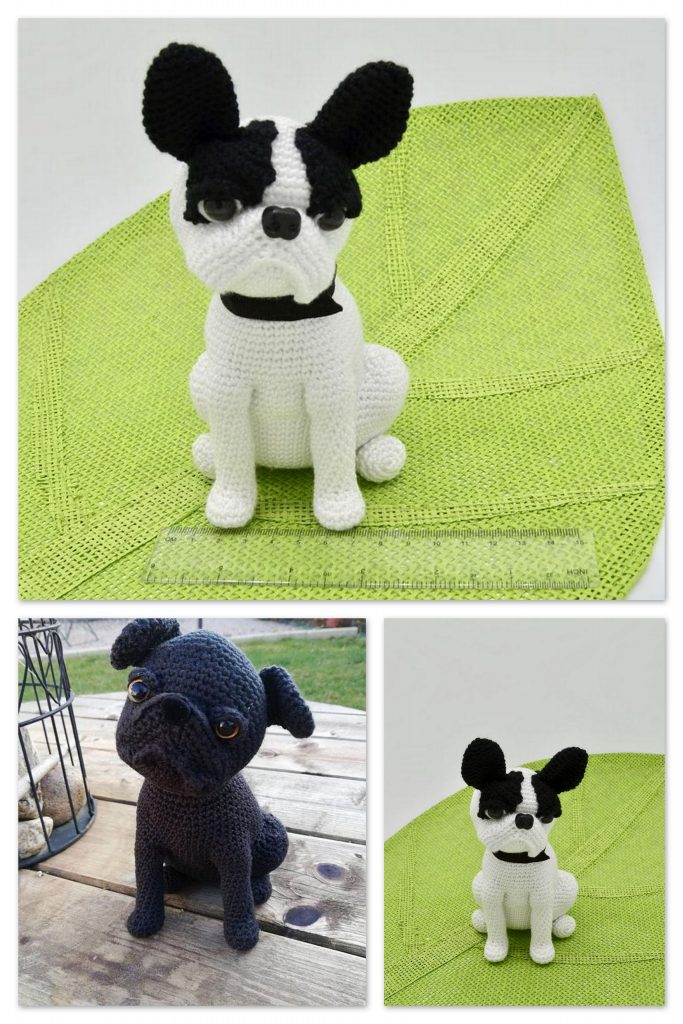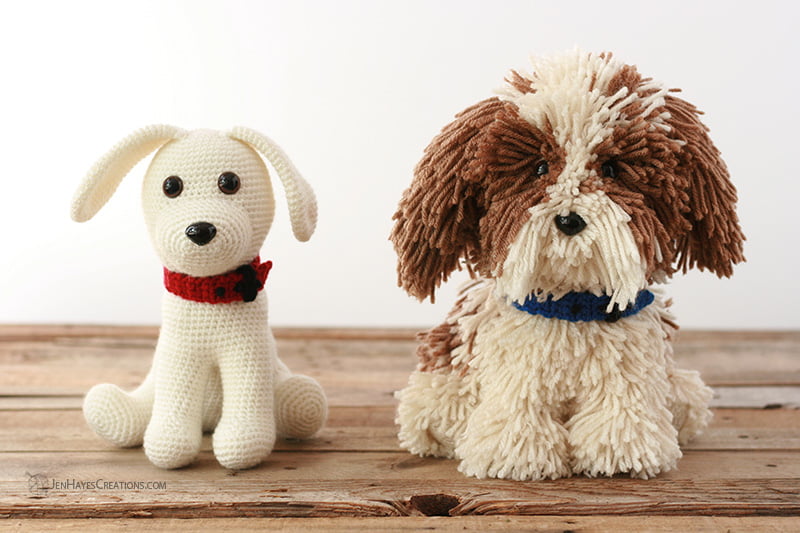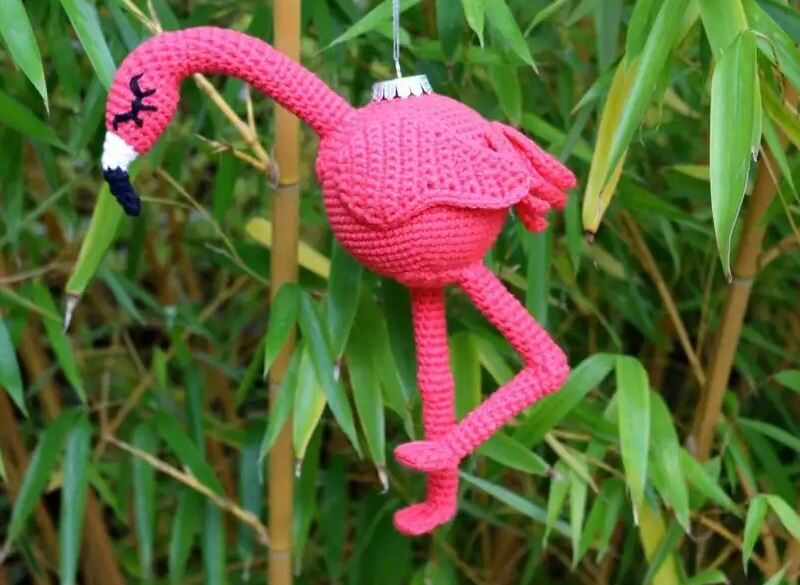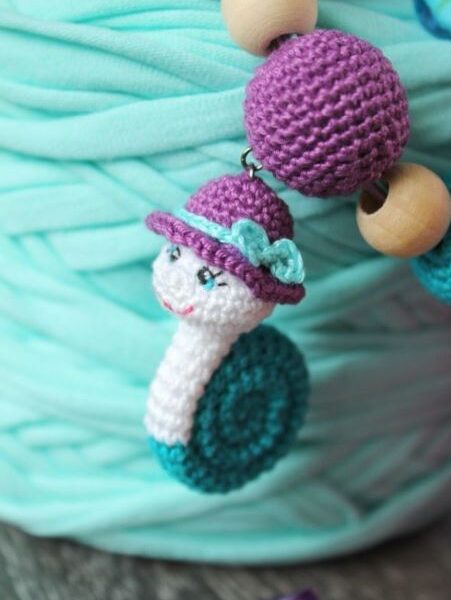If you enjoy making amigurumi, here I share this easy and free amigurumi pattern for you for free. Your kids will love these toys.
Materials
Crochet Hook, Size E/4 (3.5 mm)
Stitch Marker(s)
Scissors
Stuffing
Tapestry Needle
Pins
Safety Eyes, 15 mm (I used brown)
Safety Nose, 20 mm (I purchased mine locally at Hobby Lobby but they look like these ones for reference)
Chopstick, dowel, or something similar to help with stuffing
Red Heart Super Saver (worsted 4-Medium, 100% acrylic, 364 yds/333 m, 7 oz/198 g):
– Regular Dog: Color (A) Soft White OR Aran OR Color of choice, used approx. 239 yds/219 m
– Fluffy Dog: Color (A) Soft White OR Aran, yards, used approx. 499 yds/456 m, Color (B) Black OR Cafe Latte, used approx. 230 yds/186 m
– Collar: Color (C) Ranch Red OR Royal OR Dark Orchid OR Color of choice, used approx. 10 yds/9 m, Color (D) Black, used approx. 3 yds/3 m
Abbreviations/Stitches Used
ch – Chain
Rnd(s) – Round(s)
Rows – Rows
sc – Single crochet
sc2tog – Single crochet 2 stitches together (I use the invisible decrease when working in the Rnd)
sl st – Slip stitch
st(s) – Stitch(s)
[ ] – Work instructions between brackets as many times as directed
magic circle/adjustable ring
Amigurumi dog free pattern
Body
Using Color A, Make 1
Rnd 1: 6sc in adjustable (magic) circle (6sts)
Rnd 1 alternative: If you don’t know how to/do not like using an adjustable circle you can ch2 and then 6sc in 2nd chain from hook (6sts)
Rnd 2: 2sc in each st (12sts)
Rnd 3: [Sc in the next st, 2sc in next st] 6 times (18sts)
Rnd 4: [Sc in the next 2sts, 2sc in the next st] 6 times (24sts)
Rnd 5: [Sc in the next 3sts, 2sc in the next st] 6 times (30sts)
Rnd 6: [Sc in the next 4sts, 2sc in the next st] 6 times (36sts)
Rnd 7: [Sc in the next 5sts, 2sc in the next st] 6 times (42sts)
Rnd 8: [Sc in the next 6sts, 2sc in the next st] 6 times (48sts)
Rnd 9: [Sc in the next 7sts, 2sc in the next st] 6 times (54sts)
Rnd 10: Sc in the next 19sts, 2sc in the next st, [sc in the next 2sts, 2sc in the next] 5times, sc in the next 19sts (60sts)
Rnds 11-12: Sc in each st around (60sts for 2Rnds)
Rnd 13: Sc in the next 23sts, sc2tog, [sc in the next 6sts, sc2tog] 2times, sc in the next 19sts (57sts)
Rnds 14-17: Sc in each st around (57sts for 4Rnds)
Rnd 18: Sc in the next 22sts, sc2tog, [sc in the next 5sts, sc2tog] 2times, sc in the next 19sts (54sts)
Rnds 19-22: Sc in each st around (54sts for 4Rnds)
Rnd 23: [Sc in the next 7sts, sc2tog] 6 times (48sts)
Rnds 24-26: Sc in each st around (48sts for 3Rnds)
Rnd 27: [Sc in the next 6sts, sc2tog] 6 times (42sts)
Rnds 28-29: Sc in each st around (42sts for 2Rnds)
Rnd 30: [Sc in the next 5sts, sc2tog] 6 times (36sts)
Rnds 31-32: Sc in each st around (36sts for 2Rnds)
Fasten off. Leave a long tail for sewing.
Shape and firmly stuff your piece.
Front Legs
Using Color A, Make 2
>Design Note: You will be making two front legs. For the first leg, you will fasten off when noted to do so. With the second leg, you will NOT fasten off.
Rnd 1: 6sc in adjustable (magic) circle (6sts)
Rnd 1 alternative: If you don’t know how to/do not like using an adjustable circle you can ch2 and then 6sc in 2nd chain from hook (6sts)
Rnd 2: 2sc in each st (12sts)
Rnd 3: [Sc in the next st, 2sc in next st] 6 times (18sts)
Rnd 4: [Sc in the next 2sts, 2sc in the next st] 6 times (24sts)
Rnd 5: [Sc in the next 3sts, 2sc in the next st] 6 times (30sts)
Rnds 6-8: Sc in each st around (30sts for 3Rnds)
Rnd 9: [Sc2tog] 5 times, sc in the next 20sts (25sts)
Rnd 10: Sc2tog, sc in the next st, sc2tog, sc in the next 20sts (23sts)
Rnd 11: [Sc2tog] 2 times, sc in the next 19sts (21sts)
Rnd 12: Sc2tog, sc in the next 19sts (20sts)
Begin to firmly stuff and shape your piece and continue to do so as you progress.
Rnds 13-21: Sc in each st around (20sts for 9Rnds)
Fasten off, leaving a long tail if making Leg 1 and set it aside. If making Leg 2 continue as directed below.
Rnd 22: Sc in the next 6sts, leave the remaining stitches unworked (6sts)
>Design Note: These 6 stitchesshould make it so your hook is now at the front inner side of the leg so that when you place the other leg next to it you will be able to join them together nicely. You should be able to join to the 2nd to last st on Leg 1 (stitch number 19) and have both feet facing forward. If this is not the case then it’s likely that our tensions are different. Not a big deal, simply add or remove stitches until you are lined up as described.
Rnd 23: Join Leg 2 to Leg 1 with a sc into st 19 of Leg 1 (Two stitches back from where you originally fastened off). Mark this stitch! This is the new starting point for the round. You can remove any other stitch markers that you may have in your work, sc in the remaining 19sts on Leg 1. You’re now going to join back onto Leg 2 with a sc in the st right next to where you attached to Leg 1 and then in each of the remaining 19sts (40sts total)
>Design Note: There will likely be a small hole in between the two pieces where they were joined. You’ll take care of this in a moment.
Rnds 24-25: Sc in each st around (40sts for 2Rnds)
>Design Note: If on Rnd 24 you happen to be coming up one st short, watch out for st number 21 at the center back. With the way the piece forms, it likes to hide.
Now is a good time to use the tail you left when you fastened off Leg 1 and use it to sew up the little hole between the legs.
Attaching the Legs and Body Together
Okay, now you’re going to attach the legs to the body. You’re going to skip 10sts on the body and 10sts on the legs. To do this you’re going to need to figure out a few placement points. Get two stitch markers ready and I’ll walk you through it.
Determining Where to Place Your Stitch Markers
On the body, we want to skip the front 10 sts. You’re going to use the tail on your body to help determine which 10 sts. With the tail being the center front st, count out in both directions from the tail for a total of 10sts. Place one stitch marker in the first st you will skip and another in the tenth st you will skip.
Okay, now you can set the body aside for a minute while you work on the legs. For this, you’re going to begin Rnd 26 to help identify the 10sts that you’re going to skip.
- Rnd 26: Sc in the next 15 sts, stop and count sts 16-25, put a stitch marker in the 16th and the 25th st (your 10 skipped sts), now pick up your body and line up your skipped sts. Sc into the st directly left of your stitch marker on the body and then in each st around the body until you get to your second stitch marker (a total of 26sts between the stitch markers on the body and 41sts total for the row thus far).
Now you’re going to join the body back onto the other side of the legs.
- Rnd 26 continued: Sc into the st directly left of the stitch marker on the leg, and sc each of the remaining 14sts. (56sts total)
>Design Note: You can now remove all the stitch markers other than the one that marks your first stitch of the round.
- Rnd 27: [Sc in the next 5sts, sc2tog] 8 times (48sts)
>Design Note: The sts where you joined to the body/leg may look smaller/different than those around them. If your stitch count is off you may be accidentally passing over them.
- Rnd 28: Sc in each st around (48sts)
- Okay, now you’re going to take a minute to stitch the body and legs together at the point where you skipped the 10 stitches. I used the tail left on the body. On the inside of your dog (as opposed to the right side) work through the top sts on both the body and the legs and whip stitch them together. Because the tail is in the middle you will need to work one direction, weave back to the center and then stitch up the other side, or get a new length of yarn and stitch it up.
- Rnds 29-30: Sc in each st around (48sts for 2Rnds)
- Rnd 31: [Sc in the next 5sts, sc2tog] 2 times, sc in the next 22sts, sc2tog, sc in the next 3sts, sc2tog, sc in the next 5sts (44sts)
- Rnd 32: Sc in the next 10sts, sc2tog, sc in the next 21sts, sc2tog, sc in the next 9sts (42sts)
- Rnd 33: [Sc in the next 4sts, sc2tog] 3 times, sc in the next 14 sts, sc2tog, sc in the next 2sts, sc2tog, sc in the next 4sts (37sts)
- Rnd 34: Sc in the next 9sts, sc2tog, sc in the next 17sts, sc2tog, sc in the next 7sts (35sts)
Continue to firmly stuff and shape the body cavity as you go.
- Rnd 35: Sc in the next 8sts, sc2tog, sc in the next 18sts, sc2tog, sc in the next 5sts (33sts)
- Rnd 36: [Sc in the next 8sts, sc2tog] 2 times, sc in the next 5sts, sc2tog, sc in the next 6sts (30sts)
- Rnd 37: Sc in each st around (30sts)
- Sl st to the first st, fasten off, leaving a tail for sewing the head to the body.
Head
Using Color A, Make 1
The head is worked top-down.
- Rnd 1: 6sc in adjustable (magic) circle (6sts)
- Rnd 1 alternative: If you don’t know how to/do not like using an adjustable circle you can ch2 and then 6sc in 2nd chain from hook (6sts)
- Rnd 2: 2sc in each st (12sts)
- Rnd 3: [Sc in the next st, 2sc in next st] 6 times (18sts)
- Rnd 4: [Sc in the next 2sts, 2sc in the next st] 6 times (24sts)
- Rnd 5: [Sc in the next 3sts, 2sc in the next st] 6 times (30sts)
- Rnd 6: [Sc in the next 4sts, 2sc in the next st] 6 times (36sts)
- Rnd 7: [Sc in the next 5sts, 2sc in the next st] 6 times (42sts)
- Rnd 8 [Sc in the next 6sts, 2sc in the next st] 6 times (48sts)
- Rnd 9: [Sc in the next 7sts, 2sc in the next st] 6 times (54sts)
- Rnds 10-12: Sc in each st around (54sts for 3Rnds)
- Rnd 13: [Sc in the next 8sts, 2sc in the next st] 6 times (60sts)
- Rnds 14-20: Sc in each st around (60sts for 7Rnds)
- Rnd 21: [Sc in the next 8sts, sc2tog] 6 times (54sts)
- Rnds 22-24: Sc in each st around (54sts for 3Rnds)
- Rnd 25: [Sc in the next 7sts, sc2tog] 6 times (48sts)
- Rnd 26: [Sc in the next 6sts, sc2tog] 6 times (42sts)
- Rnd 27: [Sc in the next 5sts, sc2tog] 6 times (36sts)
>Design Note: Now would be a great time to insert your eyes. I place mine between Rnds 14 and 15 and about 8sts apart. Note that getting the 15 mm posts through the tightly crocheted fabric was a bit of a wrestling match. Be determined to win! It helped me to take my chopstick and insert it into the space where I wanted the eye to go so that is expanded some, but even then, there was a bit of a struggle to get the post through. Using smaller eyes is an option, but my preference was the look of the 15 mm sized eye.
Now that your eyes are inserted and in place, firmly shape and stuff your head and continue to do so as you go right up to the very end.
- Rnd 28: [Sc in the next 4sts, sc2tog] 6 times (30sts)
- Rnd 29: [Sc in the next 3sts, sc2tog] 6 times (24sts)
- Rnd 30: [Sc in the next 2sts, sc2tog] 6 times (18sts)
- Rnd 31: [Sc in the next st, sc2tog] 6 times (12sts)
- Rnd 32: [Sc in the next st, sc2tog] 4 times (8sts)
- Sl st to the first st, fasten off, leave a tail for stitching up the hole.
> Design Tip: I think the hole closes more nicely if you close it with your tapestry needle, working in the front loops only and work with your needle from the inside of the hole out in each stitch around until the hole is completely closed. Tie off. Bury your yarn end and cut off any excess.
Muzzle
Using Color A, Make 1
- Ch 6
- Rnd 1: Working around both sides of the chain, starting by working in the back bars of the chain, 2sc in the 2nd ch from the hook, sc in the next 3sts, 3sc in the last st (you’ve now rounded the corner and completed the first st on the other side of the chain), sc in the next 4sts (12sts)
- Rnd 2: Sc in the next st, 2sc in the next st, sc in the next 3sts, 2sc in the next st, sc in the next st, 2sc in the next st, sc in the next 3sts, 2sc in the next st (16sts)
- Rnd 3: Sc in the next 2sts, 2sc in the next st, sc in the next 3sts, 2sc in the next st, sc in the next 3sts, 2sc in the next st, sc in the next 3sts, 2sc in the next st, sc in the next st (20sts)
- Rnd 4: [Sc in the next st, 2sc in the next st] 10 times (30sts)
- Rnd 5: Sc in the next st, 2sc in the next st, sc in the next 2sts, 3sc in the next st, sc in the next 8sts, 3sc in the next st, sc in the next 2sts, 2sc in the next st, sc in the next 2 sts, 3sc in the next st, sc in the next 8sts, 3sc in the next st, sc in the next st (40sts)
- Rnds 6-8: Sc in each st around (40sts for 3Rnds)
- Rnd 9: [Sc in the next 6sts, sc2tog] 5times (35sts)
- Sl st to the first st, fasten off, leaving a tail for stitching the muzzle to the face.
Ears
Using Color A, Make 2
- Rnd 1: 6sc in adjustable (magic) circle (6sts)
- Rnd 1 alternative: If you don’t know how to/do not like using an adjustable circle you can ch2 and then 6sc in 2nd chain from hook (6sts)
- Rnd 2: 2sc in each st (12sts)
- Rnd 3: [Sc in the next st, 2sc in next st] 6 times (18sts)
- Rnd 4: [Sc in the next 2sts, 2sc in the next st] 6 times (24sts)
- Rnds 5-6: Sc in each st around (24sts for 2Rnds)
- Rnd 7: [Sc in the next 3sts, 2sc in the next st] 6 times (30sts)
- Rnds 8-11: Sc in each st around (30sts for 4Rnds)
- Rnd 12: [Sc in the next 3sts, sc2tog] 6 times (24sts)
- Rnds 13-20: Sc in each st around (24sts for 8Rnds)
- Rnd 21: [Sc in the next 10sts, sc2tog] 2 times (22sts)
- Rnd 22: Sc in each st around (22sts)
- Rnd 23: [Sc in the next 9sts, sc2tog] 2 times (20sts)
- Rnd 24: Sc in each st around (20sts)
- Rnd 25: [Sc in the next 8sts, sc2tog] 2 times (18sts)
- Rnd 26: [Sc in the next 7sts, sc2tog] 2 times (16sts)
- Hold the top edges together and sc them together (8sts)
- Fasten off, leaving a tail for attaching to the head.
Hind Legs
Right Leg
Using Color A, Make 1
- Rnd 1: 6sc in adjustable (magic) circle (6sts)
- Rnd 1 alternative: If you don’t know how to/do not like using an adjustable circle you can ch2 and then 6sc in 2nd chain from hook (6sts)
- Rnd 2: 2sc in each st (12sts)
- Rnd 3: [Sc in the next st, 2sc in next st] 6 times (18sts)
- Rnd 4: [Sc in the next 2sts, 2sc in the next st] 6 times (24sts)
- Rnd 5: [Sc in the next 3sts, 2sc in the next st] 6 times (30sts)
- Rnds 6-8: Sc in each st around (30sts for 3Rnds)
- Rnd 9: [Sc2tog] 5 times, sc in the next 20sts (25sts)
- Rnd 10: Sc2tog, sc in the next st, sc2tog, sc in the next 20sts (23sts)
- Rnd 11: [Sc2tog] 2 times, sc in the next 19sts (21sts)
- Rnd 12: Sc2tog, sc in the next 19sts (20sts)
Begin to firmly stuff and shape your leg. Continue to do so as you go.
- Rnds 13-18: Sc in each st around (20sts for 6Rnds)
>Design Note: The rest of the leg will be worked in rows. Turn and ch1 at the end of each row
- Row 19: Sc in the next 12 sts, leave the remaining sts unworked
>Design Note: The 12sts that you just worked should be from about the front center to the back center of the piece.
- Row 20: Sc in the next 11sts, leave the last st unworked (11sts)
- Rows 21-22: Sc in each st across (11sts for 2 Rows)
- Row 23: Sc2tog, sc in the next 7sts, sc2tog (9sts)
- Row 24: Sc2tog, sc in the next 5sts, sc2tog (7sts)
- Row 25: Sc2tog, sc in the next 3sts, sc2tog (5sts)
- Row 26: Sc2tog, sc in the next st, sc2tog (3sts)
- Fasten off. Leave a tail for attaching the leg to the body.
Left Leg
Using Color A, Make 1
- Rnd 1: 6sc in adjustable (magic) circle (6sts)
- Rnd 1 alternative: If you don’t know how to/do not like using an adjustable circle you can ch2 and then 6sc in 2nd chain from hook (6sts)
- Rnd 2: 2sc in each st (12sts)
- Rnd 3: [Sc in the next st, 2sc in next st] 6 times (18sts)
- Rnd 4: [Sc in the next 2sts, 2sc in the next st] 6 times (24sts)
- Rnd 5: [Sc in the next 3sts, 2sc in the next st] 6 times (30sts)
- Rnds 6-8: Sc in each st around (30sts for 3Rnds)
- Rnd 9: [Sc2tog] 5 times, sc in the next 20sts (25sts)
- Rnd 10: Sc2tog, sc in the next st, sc2tog, sc in the next 20sts (23sts)
- Rnd 11: [Sc2tog] 2 times, sc in the next 19sts (21sts)
- Rnd 12: Sc2tog, sc in the next 19sts (20sts)
Begin to firmly stuff and shape your leg. Continue to do so as you go.
- Rnds 13-19: Sc in each st around (20sts for 7Rnds)
>Design Note: You should now be positioned just right to center front.
>Design Note: The rest of the leg will be worked in rows. Turn and ch1 at the end of each row
- Row 20: Turn, ch1, sc in the next 11sts, leave the rest unworked (11sts)
- Rows 21-22: Sc in the next 11sts (11sts for 2 Rows)
- Row 23: Sc2tog, sc in the next 7sts, sc2tog (9sts)
- Row 24: Sc2tog, sc in the next 5sts, sc2tog (7sts)
- Row 25: Sc2tog, sc in the next 3sts, sc2tog (5sts)
- Row 26: Sc2tog, sc in the next st, sc2tog (3sts)
- Fasten off. Leave a tail for attaching the leg to the body.
Tail
Using Color A, Make 1
- Rnd 1: 5sc in adjustable (magic) circle (5sts)
- Rnd 1 alternative: If you don’t know how to/do not like using an adjustable circle you can ch2 and then 5sc in 2nd chain from hook (5sts)
- Rnd 2: Sc in the next 4sts, 2sc in the next st (6sts)
- Rnd 3: Sc in the next 5sts, 2sc in the next st (7sts)
- Rnd 4: Sc in the next 6sts, 2sc in the next st (8sts)
- Rnd 5: Sc in the next 7sts, 2sc in the next st (9sts)
- Rnd 6: Sc in each st around (9sts)
Begin to stuff and shape your tail. Continue to do so as you go.
- Rnd 7: Sc in the next 8sts, 2sc in the next st (10sts)
- Rnd 8: Sc in each st around (10sts)
- Rnd 9: Sc in the next 9sts, 2sc in the next st (11sts)
- Rnd 10: Sc in each st around (11sts)
- Rnd 11: Sc in the next 10sts, 2sc in the next st (12sts)
- Rnd 12: Sc in each st around (12sts)
- Rnd 13: Sc in the next 11sts, 2sc in the next st (13sts)
- Rnd 14: Sc in each st around (13sts)
- Rnd 15: Sc in the next 12sts, 2sc in the next st (14sts)
- Rnd 16: Sc in each st around (14sts)
- Rnd 17: Sc in the next 13sts, 2sc in the next st (15sts)
- Sl st to the first st, fasten off, leaving a tail for attaching to the body.
Assembly
>Design Tip: One of the biggest tricks to assembling amigurumi, in my opinion, is pinning your pieces and then taking the time needed to ensure that you are stitching them on in a way that you are happy with them. I’ll give you some general ideas of where I placed my pieces, but ultimately, do what looks best to you.
>Design Tip: Remember when attaching your pieces to add more stuffing each time right before closing to eliminate having a gap with no stuffing between the joined pieces.
Muzzle
Before pinning and attaching the muzzle you’ll want to make sure to add your safety nose. I placed my nose between Rnd 3 and 4 in a central position. The actual muzzle I placed about one row below the eyes.
Add stuffing to your muzzle. I stuffed mine a little and then pinned it to the face for placement. After stitching for a while I added more stuffing until I was overall pleased with the appearance and firmness.
Ears
I pinned my ears on the top of the head approximately five rounds out in either direction from the very center. The ears are NOT stuffed.
Tail
I placed the bottom part of the tail at Rnd 10 of the body.
Hind Legs
The hind legs were probably the trickiest part for me to get placed evenly. What I found that helped me the most was to place my dog on a solid surface, like a tabletop, and look at it directly from the front. This way I could see how both legs were positioned in comparison to each other.
With the hind legs, you will want to stitch all the way around the part that was worked in rows and the top part of the last round where it was left unworked. Right before closing up the leg, add stuffing to the area that was worked in rows.
Making A Fluffy Dog
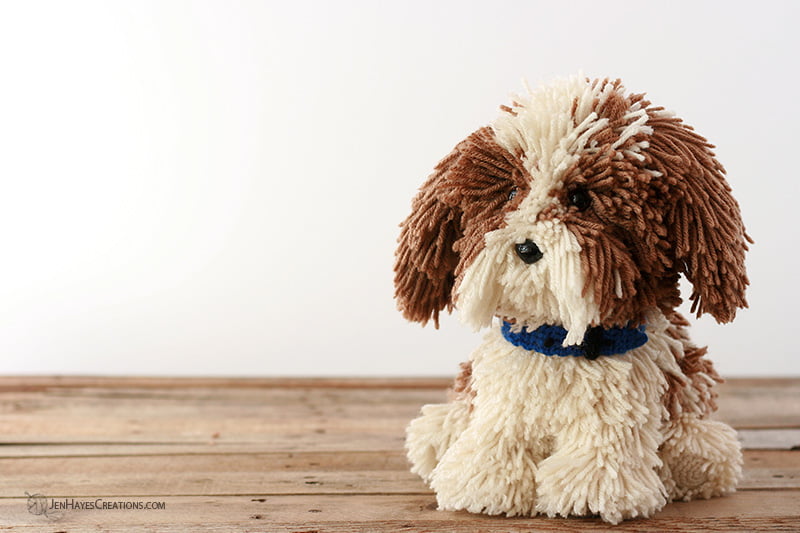
>Design Tip: It will likely be helpful to read through this entire section before beginning so you have a better idea of the entire process and then move forward as you think best.
I’ll tell you now, turning your dog into a fluffy dog is a labor of love. It’s going to take some time, but in my opinion, it’s worth it!
If you haven’t already done so, start by completing and assembling the dog pattern above. The next step involves cutting a whole lot of lengths of yarn. My lengths of yarn are approximately 5 inches (13 cm) long. The easiest way to do this is to cut a piece of cardboard (a cereal box will do) to 2.5 inches (6 cm) tall by 5 inches (13 cm) wide.
The width of the cardboard can actually be as long or as short as you wish. You’ll be rapping your yarn around the height of the cardboard and then cutting it off the cardboard in one place, leaving pieces that are about 5 inches (13 cm) in length.
Personally, I placed my yarn tail at the bottom of the cardboard rectangle, wrapped it around about 50 times and then slipped my scissors between the cardboard and the yarn at the very bottom and cut it there. This way no yarn was wasted.
How many lengths of yarn will you need? Well, this will vary some. I advise you to think about the pattern that you want on your dog. Perhaps you have a dog and you’d like to mimic their pattern. You could also look online at dogs, or just make up your own.
Call me crazy, but I went ahead and counted the strands as I went to give you an idea of how many I used in my design. Exactly how many you need may vary widely, so it may be a good idea to cut quite a few to get you started and then cut more as you go along. For the brown and tan dog, I cut 1,734 strands of Color A and 1,418 strands of Color B. Like I said, a labor of love because now that they’re cut it’s time to loop them onto the dog, but it’s gonna be worth it!
I’m going to give you a general idea of my process for looping, but if you find a better method, by all means, use it.
I personally started my loops around the eyes and the nose, using Color B. This is a tricky area to work around because the eyes and nose are attached there. Work as closely as you can, even sticking your hook under the edges if you can, all the way around, trying to completely fill in the space. Personally, my goal was to not have any Color A showing through.
Once this is done you can really start working wherever you want. Personally, I just continued working on the face and head in a combination of Color A and Color B (as I’d decided based on my desired pattern) and then moved out to the other parts of the body. The whole bottom portion of my dogs are worked in Color A so I opted to fill in most of this color first and then went in with Color B.
Let’s Talk About How to Make Loops
- The loops are placed around one complete stitch in a row. Determine where the loop will be placed, insert the hook from the bottom of the stitch, around the back, and back up at the top of the stitch. Fold the length of yarn in half and hook it onto the hook.
- Pull the length of yarn through the stitch about halfway.
- Remove the hook and take the loop, placing it up over both of the yarn tails.
- Pull on the yarn tails at the same time to tighten and secure the loop.
Let’s Talk About Yarn Loop Placement
Other than right around the eyes and the nose where I placed Color B as solidly as possible, I worked the rest of the loops around every other row of stitches for the most part. I felt this provided adequate coverage and fluffiness. If a spot looked a little bare than I added a few loops along parts of the skipped row, but not complete rows. That said if you want an even fluffier dog simply add more loops everywhere.
There were a few spots that I opted to leave unworked completely. The first of these was the 5Rnds on the bottom of each of the feet. The second is underneath each of the ears. For the ear, I worked 2sts on either edge of the underside of the ear and then a couple of complete rows at the very bottom, but I then left the rest of the middle underside of the ear alone.
Let’s Talk About Blending
To me, stopping Color A and just beginning with Color B looked too abrupt in some ways. To eliminate this and to create a “blend” with the yarns, about 2 rows before I switched to Color B I worked those two (or so) rows differently. I kept them primarily Color A, but every third stitch or so I made it Color B. Then on the next row I did the same thing but made sure not to line up any of the Color B stitches. After this, I switched fully to Color B to finish out my desired pattern. Blending accomplished!
Another thing I did when I wasn’t quite satisfied with how the blending looked was to loop in either Color A or Color B (depending on what was needed to make a better blend) onto some of the stitches in the rows that were skipped.
Trimming
There’s a super cute face hidden under all that fluff! Let’s find it!
This part is both fun and a bit messy. Be prepared to have yarn fluff everywhere! How you decide to sculpt your dog is going to be left up to you for the most part, but I’ll give you a few tips.
- Get a clear picture in your head (and even better an actual picture) of how you want your dog to look.
- Start with the face and then the front legs. Once satisfied with these, move on to other parts.
- Trimming less and in multiple passes is probably always the best idea. The hair obviously won’t grow back so if you take off small bits at a time as opposed to large, deep chunks it’s easier to fix if needed. That said if you totally dislike an area that you cut you can make more loops and switch them out, but this likely won’t be too fun.
- Use your initial trimming passes to add shape to your dog and then focus on more detailed trimming.
- Sometimes it’s hard to know when to stop. Take your time. Walk away if you’re feeling frustrated or don’t know exactly what you want to do next.
- Have fun! All dogs look different. Yours will be unique no matter what!
Collar
Regular Dog’s Collar
Using Color C, Make 1
The size of collar you make will depend on if you made a regular dog or if you made a fluffy dog. It’s easy to adjust the collar to any size you choose.
>Design Note: Leave a long starting tail for stitching.
- Ch 4
- Row 1: Sc in the 2nd ch from the hook and in each st across (3sts)
- Rows 2-50: turn, ch1, sc in each st across (3sts for 49 Rows)
Measure the collar around the dog’s neck. It should go around with a small amount of slack and overlap about 12 rows or so. Add or subtract rows as necessary.
- Row 51: Sc2tog, sc in the last st (2sts)
- Row 52: Sc2tog (1st)
- Fasten off. Weave in this tail.
>Design Option: Add three French knots (or whip stitches) evenly spaced onto the collar piece on the pointy end to imitate holes in the collar. Mine are at about Row 48, 45, and 42.
Loop Strap
Using Color D, Make 1
- Ch2
- Row 1: Sc in the 2nd ch from the hook (1st)
- Rows 2-11: turn, ch1, sc (1st for 10 Rows)
- Fasten off. Leave a tail for stitching the loop together.
- Weave in the first tail. Form into a loop and stitch closed.
- Weave in the end.
- Slide the black loop onto the collar.
- Stitch collar around your dog’s neck at about Row 43 of the collar. Make sure it isn’t twisted!
- Slip the flap with the French knots through the loop.
Stitching the collar around the dog’s neck.
Fluffy Dog’s Collar
Using Color C, Make 1
>Design Note: Leave a long starting tail for stitching.
- Ch 4
- Row 1: Sc in the 2nd ch from the hook and in each st across (3sts)
- Rows 2-71: turn, ch1, sc in each st across (3sts for 70 Rows)
Measure the collar around the dog’s neck. It should go around with a small amount of slack and overlap about 12 rows or so. Add or subtract rows as necessary.
- Row 72: Sc2tog, sc in the last st (2sts)
- Row 73: Sc2tog (1st)
- Fasten off. Weave in this tail
>Design Option: Add three French knots (or whip stitches) evenly spaced onto the collar piece on the pointy end to imitate holes in the collar. Mine are at about Row 67, 64, and 61.
Loop Strap
Same pattern as for the Regular Dog’s Collar above.
More Amigurumi Dog İdeas




